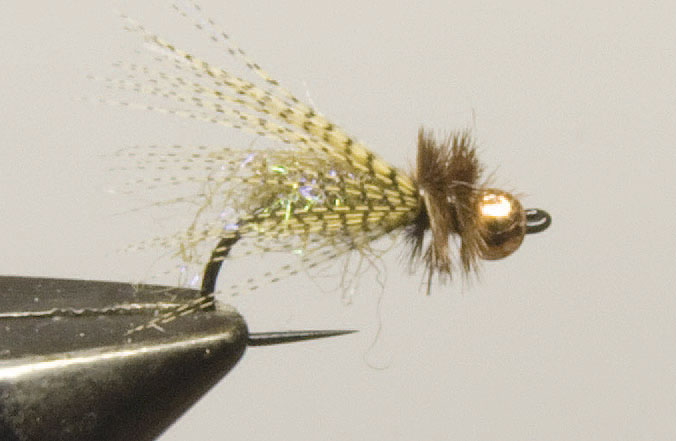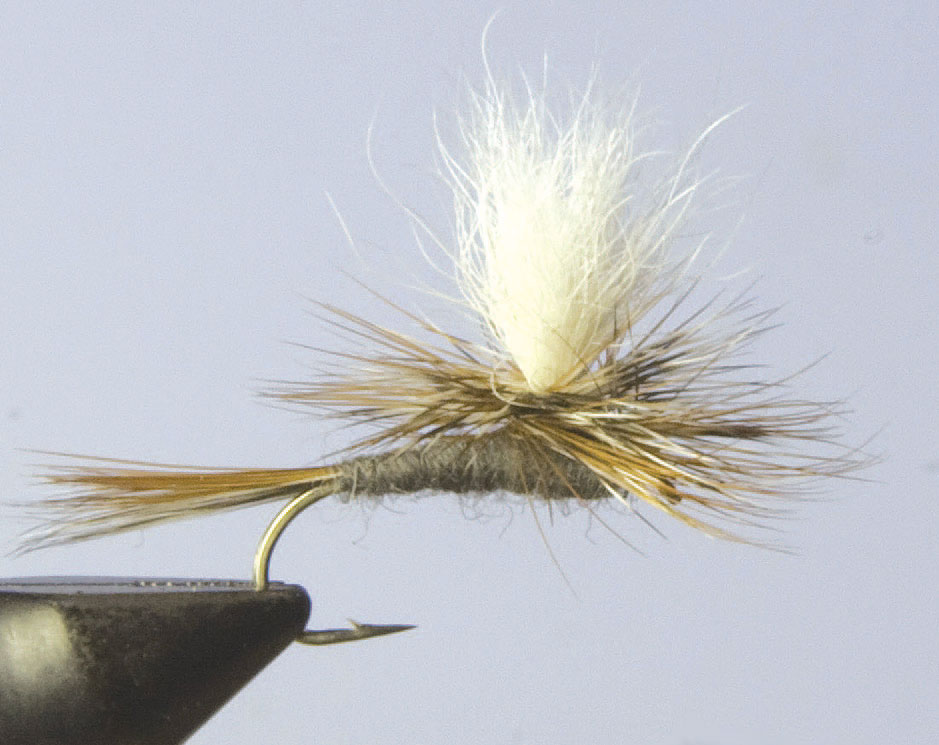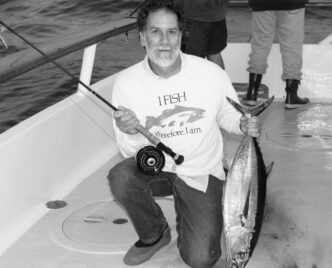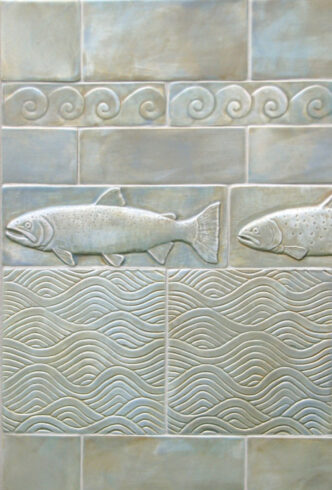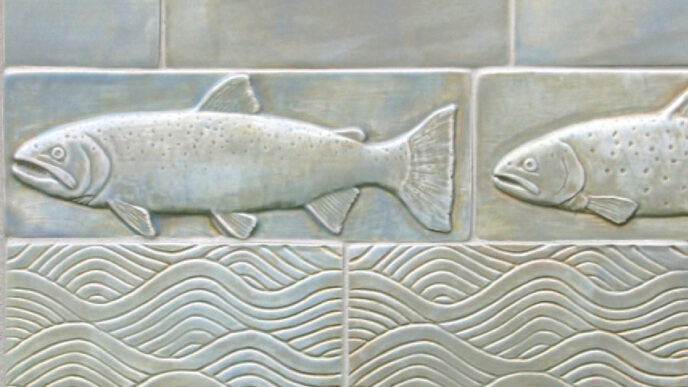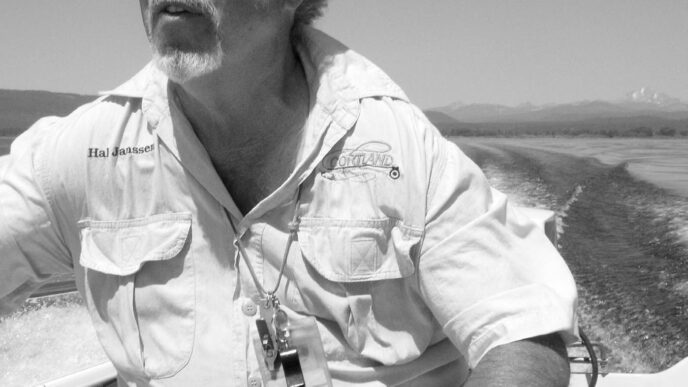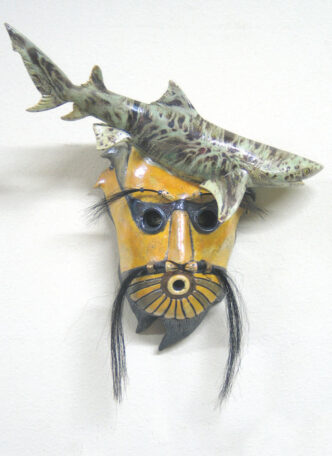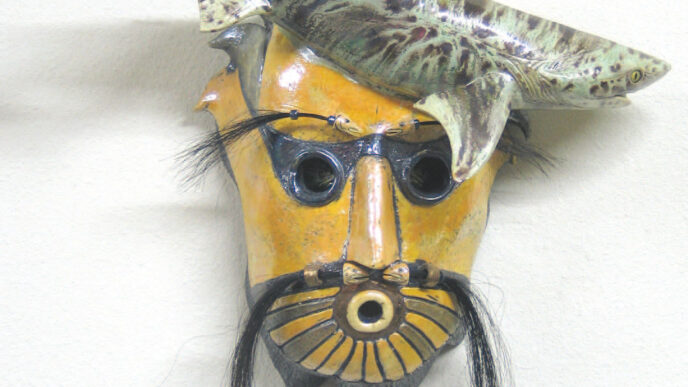Call him nameless. Ever since this relatively recent descendent of Homo erectus tied the first fly in his prehistoric man cave in an effort to put food on the stone they used for a table, there’s been one standard by which all fishing flies have been judged. It still appears somewhere in almost every essay about fly tying. All of these end, or should, with the message that a fly is good enough if it serves the purpose for which you tied it: to catch big fish, many fish, fish of specific species, or the attention of customers, show attendees, impressionable children, or friends. A fly’s just fine if it provides you satisfaction, never mind what the trout said. Likewise, a tying book is good enough if it teaches what you want to learn the way you want to learn it, so you can tie flies that are “good enough.”
Everything else is just commentary. Of course, that’s where things get interesting.
Late last century, I listened to Andy Puyans reminisce about the paucity of fly-tying primers during the World War II years he spent in hospital beds recovering from polio and clogging ventilators with feathers. I vaguely recall mention of a pamphlet distributed by Jim Daren of The Angler’s Roost; I suspect he had E. C. Gregg’s How to Tie Flies, a book the author hoped would “throughout its entirety teach in a practical manner the Art of Fly Tying in all its branches.” One thing’s for sure: brilliant new tomes did not arrive monthly to enlighten the young master.
Brilliant new tomes . . .
Fly-tying books now enjoy a golden age — real gold, not gilt: how-tos so clearly illustrated that if the subject were nuclear physics, “just folks” might be cooking up antimatter in Crock-Pots during the down hour between dinner and Glee. Credit mechanical advances for part of this — far better and cheaper cameras; changes in the processes and price of four-color printing; also an abundance of innovative fly designers using new materials. But those are more about how than why: publishers trust that we, their market, desire and will pay for books that must, in their turn, get better and better to be “good enough.”
A hundred? Two hundred, over the last 15 years? Just in the United States, I mean. Specialized books: flies for trout in spring creeks, still waters, and small streams; flies offered by region, state, or specific water; by single species of insect, also stages of insect life — nymphs, emergers, adult dries; by size — micro; even by the element of origin, as in terrestrial. We have material how-tos for hair, CDC, foam — even books of variations on one woolly pattern. And the collections? From individual designers, large organizations, medium-sized clubs, single companies (once disguised), and, recently, a loose group of friends. As for salmon, Pacific and Atlantic, also steelhead (which on our coast are now outnumbered by flies tied to catch them), we have books on “traditional,” “modern,” “contemporary,” “simplified,” tube style, and Spey flies displaying objects so gorgeous that no other sport can claim anything like them, except ice skating, which doesn’t count because they’re dressing real girls.
Don’t stop there: Bass tying books burst out — ties for striped and mouths both large and small — offering opportunities for the wildest innovation, including flies that mate pole-dancing action to the bodies of fish, birds, crustaceans, and frogs that wear faces stolen from circus clowns. However hot, these can’t begin to keep pace with new works for saltwater patterns, intended for everything from bonefish to marlins, fished on flats, in estuaries, and the deep ocean blue.
A hundred? Two hundred? More? Add to these my most favorite, astonishing tomes, collecting every fly-tying process developed between the time of Nameless and the copyright date . . .
In sum, fly-tying themes probably represent the majority of fly-fishing books published today. To some fly fishers, however, that may suggest overkill. But let’s not rush there yet, especially since much of the overkill crowd has rushed on to read something else . . .
Back to Andy: although I’ve never seen Gregg’s How to Tie Flies, I wondered about it last week while perusing to review the latest amazing manual to land on my porch, Charlie Craven’s Charlie’s Fly Box,a 220-page hardback how-to printed on 8.5-by-11 quality sheets. Per the jacket blurb, it boasts “over 750 step-by-step photos” that illustrate how to tie 17 patterns, beside which you will find portraits of several score of the patterns’ cousins.
Before you do the math, I think that the number 750 also includes shots of materials and variations on the sample-tie themes. At least, the instructions for each fly don’t average 44 photos.
Not . . . quite. But some go beyond that, and half that many for a fly to fish may seem like a lot to some — my friend Dave, for example, who was obliged to fill his wife’s boxes as well as his own, also his best friend’s and his wife’s, so had a “threematerial rule” that allowed him to keep his day job. That means maybe 8 or 10 tying steps at most. I think something similar applies to the guides I’ve tied with, most of whom moonlighted as commercial tyers: five materials, maybe seven — rarely nine. Say three times that many processes, at most, to fix these in place. A quick perusal of David Klausmeyer’s Guide Flies suggest these numbers are more or less right.
Now, material handling can get complicated. Also, some steps are far more complex than others, and authors break these down differently, depending on their preferences, assumptions about the skills of those they instruct, and the cost of taking and printing color photos. No question that most would have liked to illustrate in more detail . . . .
Which is exactly what Craven does: many (but not all) pattern series begin with a photo showing precisely how far to wrap thread down the hook shank. But what at first seems, well, indulgent, usually isn’t. For example, the fly he calls Bonefish Junk uses four steps to bed, mount, and glue its bead-chain eyes, while a similar-looking process, attaching barbell eyes to the next fly, gets seven photos, partly to ensure that a tyer creates a bond appropriate for the stresses of the greater weight.
Maybe it was that kind of close attention that reminded me of Puyans as his mitts clipped an emerger head by an additional 12 degrees, the better to imitate a later stage of a hatch. All I know for sure is that at step 25 of Craven’s Charlie Boy Hopper, I found myself thinking “Andy, you really should see this.” On the other hand, I admit that when Craven finished the Charlie Boy at Step 59, I know — and have elsewhere reported — that I needed a drink.
That’s not a criticism. People need drinks for all kinds of reasons, so don’t presume anything, and I wanted another at step 89, fin of the author’s great-looking Raven’ Craven — a fly I really like, must have, and will probably buy. By that time, a small voice in my head was wondering “How good does this get?” — meaning this book and tying books in general — even as another blurted a chorus that grayhaired people will remember from “Mrs. Robinson,” as in “Whoa whoa whoa.”
Step 89?
Craven’s intent is to demonstrate techniques and reveal materials. His photos are astonishingly clear, clean, and carefully captioned. Not only that, his preface to each series explain the pattern’s origin, influences, and use. And note this: when a simple, two-material design serves best, that’s what the author offers. Not only that, but none of the 17 starring flies are meant as show ties, and Umpqua sells 15 Craven patterns out of the bins of stores near you.
Finally, it’s important to mention that this is Craven’s second or third book, that he loves to fish — actually to fish, as in water — that he also guides, so runs a successful business or two, and is a family man with kids and friends. In short, however many steps Craven takes to tie a fly, he has a life.
I add that bit of bio for good reason, on the way to a wider, exaggerated view of tying tribes to which Craven does not belong.
Long-standing myth leads us to believe that the most exacting of vise artistes eschew human contact — or have been eschewed. It’s possible for you to imagine them living in small pools of artificially produced “natural light,” emerging
occasionally to drink alone, scavenge moldy hats, and haunt herons’ nests. The most merciless rumors insist that some can’t or won’t fish at all, fear insects, and in place of personalities have syndromes identified either by acronyms or through overt references to an orifice common to all mammals, save for several marsupials that have two.
All that’s true. Or so I’m told, often, about a few dozen skulkers at the far, Far Eastern edge of the Atlantic Salmon Fly Crowd, tyers who might kill the last passenger pigeon again if an authentic pattern required its pinfeather for an underwing. They are the Taliban of the mainstream
traditional tyers, excoriated by the responsible, an irritant to federal agencies . . .
That said . . . the works of both fringe and mainstream and the books in which these are presented are masterpieces, breathtaking . . . among the most beautiful I’ve ever seen.
What’s also evident is that the intent with which they tie and the traditions they observe have no resemblance to those established by the hungry Nameless. Zero, zip, and none. He made a tool to capture food, while they create beauty in which function is now mostly abstract. In short, we’re talking Farmer John and his egg versus Fabergé . . .
. . . in a world with a place for both, I would argue, a world easily wide enough also to include hard-core anglers entrenched at the opposite end of the tying spectrum. (Unless they’re simply the end of another arm. While it’s not fair to define a large and diverse group by the acts and attitudes of a few, it’s fun, easy, and — as evidenced by twenty-first century political discourse — helpful when complex reality only confuses things.)
Some excellent fly fishers I know aggressively disdain complicated flies. These tyers fall, loosely and sometimes loudly, into two groups, more or less.
The fellow I nominate to represent Uncomplicated Group One makes sure to inform other fishers that the damselfly nymph he’s extracting from a big brown’s kipe was wrapped with a single material in less time than it takes an amber traffic light to turn green and probably while using only three fingers and cruise control. (Fine, we all know marabou is great stuff.) But it’s not just that fly he justifiably boasts about. There’s also a two-material midge he concocted that solved a hatch dilemma that baffled five of us for years, and a surface fly for silver salmon cruising salt flats — a dressed-down gray Gurgler — that converted not only brothers of the long rod, but also a smattering of bait-and-plug-pulling gearheads. (The latter shamelessly revert to the Old Ways on occasion, including live sacrifices, but the relations between them and Our People are polite, absent threats to “chum” with float tubers they declare they will “chop up in my prop.”)
What I’m saying, a little reluctantly, is that what he does simply, he does awfully well. While I’m not sure which fly-tying books, if any, would please such a keen minimalist, I’ve seen a trio by tyers who aim to KISS and tell. And one of them, no kidding, has a fly called “The Nameless.”
If that seems like a small selection, it’s still larger than you’ll find recently published for Uncomplicated Group Two, whose last book purchase may have been Selective Trout, by Carl Richards and Doug Swisher, back in 1971, which they read, read again, and then read some more.
Presentation folk argue that it’s skill that matters most. The strictest of them (although not Swisher and Richards) might try to use computers to calculate casting position, and their leader formula takes years to work out. They appear to insist that almost any object properly rigged and fished will outcatch an exact imitation afflicted by a millimeter of microdrag.
Frankly, these people frighten me. I know there’s much to what they’re saying. At the same time that I quibble with parts of their theory, I writhe with shame for all my shoddy habits: as in that late-night-TV moment when you’re balancing a tall gin and tonic on your belly and you surf into Jack Lalanne, immediately to cry “You’re right, you’re right! Push-ups and juice! Now dammit, Jack, please leave me alone!”
New tying books for them? I’m not sure they’d care. So . . .
Quitting these caricatures of the Uncomplicated and contemplating the broad range of the Rest of Us . . . among the fabulous books now available today, how should we choose?
Several years ago Armand Carriveau, a fine fisher and man, handed me a stonefly nymph he’d tied, so super-realistic I was sure it would lay eggs on my palm. But wait: while he will craft exquisite flies, this is the same Armand who 15 years before — when I begged him for advice on tying the tiniest midges —gently suggested I not worry too much, since trout don’t see all that well, “so you’re really just adding hackle to lint on a hook.” In other words, Armand just shapes the nails on nymphs feet for fun; this one would never get wet.
Puyans played much same way: while he might alter the cuts on a Quigley Crip-ple head by 12 degrees as the hatch moved on half an hour, he also whispered in delight when a bare hook represented a tubifex worm better than anything anybody tied. One of his disciples, among the most famous nymph fishers of my generation, relies mostly — mostly — on one tungsten-head pattern he ties two ways, “ light” and “dark,” both dubbed with blends, but adds to his baitfish poppers an articulated tail that turns just so, which by comparison makes a pulse of rabbit or fox hair look large and a little confused. (He says he’s not sure it makes a difference, but if he didn’t believe it, I doubt he’d spend extra time. I know I wouldn’t, and after trying it on a few of my own, it’s now my standard tie.)
These fishers have much in common with other anglers I think of as being brilliantly balanced. All consider presentation critically important, because presentation matters to fish. All feel the same way about flies, to the extent those flies are, for one reason or another — a place and time — critical to fish. Finally, they constantly add new observations of fish — or materials, sometimes technique — to decades of the same and bring these to their vises with energy and pleasure. Beginning with the same intent as Nameless — if not the same urgent motivation — they are toolmakers refined to artisans, and by melding form and function, they achieve Aristotle’s definition of art.
So I ask myself, at this juncture, how might they feel about tying a fly with 89 steps. As overkill, maybe, but reading Craven’s prefaces and fish-centric explanations, noting the care that guides his craft — also his inclusion of simple patterns when they’re best — I can imagine smiles of sympathy and appreciation, as well.
The fact is that “good enough” is a moving target and that from the beginning, I’ve meant to cheat my way back to “good enough for you.” And since I just have, I should add here a little lowwattage advice.
The one thing about an abundance of how-tos and primers is that you really ought to look at one or a dozen before you chose, at shops, or at very least seek advice from someone who knows both the books and your intentions. Veterans will likely recommend a classic — anything over 10 years old — some of which have been revised and reillustrated. But not many sages keep up with new offerings, which would easily cost a couple of grand a year. However marketed, many of these are better suited to certain levels of readers, and while a brand newbie confronted by Ragin’ Craven might opt for a simpler hobby, intermediates looking to apply what they know and to learn more may enjoy the challenge. (Along those lines, the majority of the tying books that I see these days — all those specific books and collections — are geared to intermediate and advanced tyers.) With all there is to see on these pages, it’s best to look before you buy.
Flies in Color
